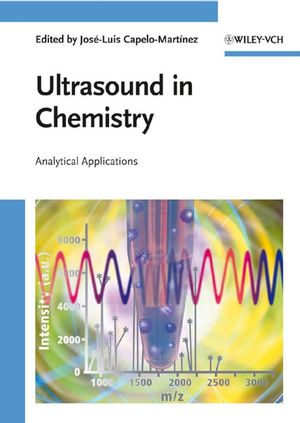Ultrasound in Chemistry: Analytical ApplicationsISBN: 978-3-527-31934-3
Hardcover
171 pages
January 2009
 |
||||||
Preface XI
List of Contributors XIII
1 The Power of Ultrasound 1
Hugo Miguel Santos, Carlos Lodeiro, and José-Luis Capelo-Martínez
1.1 Introduction 1
1.2 Cavitation 1
1.2.1 Parameters Affecting Ultrasonic Cavitation 3
1.2.1.1 Frequency 3
1.2.1.2 Intensity 4
1.2.1.3 Solvent 5
1.2.1.4 Temperature 5
1.2.1.5 External Pressure and Bubbled Gas 5
1.2.1.6 Direct and Indirect Ultrasonic Application 6
1.3 Common Ultrasonic Devices Used in Analytical Chemistry 6
1.3.1 Ultrasonic Bath 6
1.3.1.1 Types of Ultrasonic Baths 7
1.3.1.2 How to Locate the Most Efficient Place Inside an Ultrasonic Bath 8
1.3.1.3 Temperature Control 8
1.3.1.4 Shape and Material of Reaction Container 9
1.3.2 The Ultrasonic Probe 9
1.3.2.1 Parts of an Ultrasonic Probe 10
1.3.2.2 Types of Ultrasonic Probes 10
1.3.2.3 Dead Zones 11
1.3.2.4 How to Choose the Correct Ultrasonic Probe 12
1.3.2.5 Temperature Control 13
1.3.2.6 Shape and Material of Reaction Container 14
1.4 Current Ultrasonic Devices for New Analytical Applications 14
References 15
2 Ultrasonic Energy as a Tool for Sample Treatment for the Analysis of Elements and Elemental Speciation 17
Hugo Miguel Santos, Carlos Lodeiro, and José-Luis Capelo-Martínez
2.1 Introduction 17
2.2 Parameters Influencing Element Ultrasonic Solid–Liquid Extraction 17
2.2.1 Extracting Reagent 17
2.2.1.1 Extracting Reagents for Total Element Extraction 18
2.2.1.2 Extracting Reagents for Elemental Speciation 19
2.2.1.3 Extracting Reagents for Sequential Extraction Schemes 19
2.2.2 Matrix Properties 20
2.2.2.1 Type of Matrix 20
2.2.2.2 Mass of Matrix 20
2.2.2.3 Sample Size 22
2.2.3 Ultrasonic Device 22
2.2.3.1 Type of Ultrasonic Device 22
2.2.3.2 Time of Ultrasonication 23
2.2.3.3 Ultrasonic Amplitude 23
2.2.3.4 Ultrasonic Frequency 23
2.2.3.5 Temperature of Sonication 23
2.3 US-SLE from Soils and Sediments 24
2.4 US-SLE from Sewage Sludge 24
2.5 US-SLE Extraction from Plants 24
2.6 Extraction from Soft Tissues 27
2.7 Total Element Determination 27
2.7.1 US-SLE and US-SS for F-AAS 27
2.7.2 US-SLE and US-SS for ET-AAS 28
2.7.3 US-SLE and US-SS for CV and HG Employed with AAS or AFS 28
2.8 Elemental Fractionation and Elemental Speciation 30
2.8.1 What is Speciation? 30
2.8.2 Shortening Sequential Fractionation Schemes 31
2.8.3 Speciation for Soils and Sediments 34
2.8.4 Speciation from Plants 34
2.8.5 Speciation from Soft Tissues 36
2.8.6 Speciation from Other Types of Samples 43
2.9 On-Line Applications 45
2.9.1 Open and Closed Systems 46
2.9.2 UB 47
2.9.3 UP 47
2.10 Current Trends 48
2.10.1 Accelerating Liquid–Liquid Extractions 48
2.10.2 Chemical Vapor Formation 49
2.11 Conclusion 49
References 50
3 Ultrasonic Assisted Extraction for the Analysis of Organic Compounds by Chromatographic Techniques 55
Raquel Rial-Otero
3.1 Introduction 55
3.2 Overview of Classic and Modern Extraction Procedures for Organics 56
3.3 Ultrasonic Assisted Extraction (UAE) 60
3.3.1 Basic Principles 60
3.3.2 Parameters Influencing Ultrasonic Assisted Extraction 61
3.3.2.1 Amount of Sample 61
3.3.2.2 Sample Particle Size 61
3.3.2.3 Extraction Solvent 61
3.3.2.4 pH of Extracting Solution 62
3.3.2.5 Solvent Volume 62
3.3.2.6 Sonic Power 62
3.3.2.7 Frequency 63
3.3.2.8 Extraction Time 63
3.3.2.9 Extraction Temperature 63
3.3.3 Applications 63
3.3.3.1 Liquid Samples 64
3.3.3.2 Solid Samples 64
3.3.3.3 Clean-Up 70
3.4 Coupling Ultrasound with Other Extraction Techniques 71
3.4.1 Coupling Solid Phase Microextraction (SPME) and Ultrasound 71
3.4.1.1 Improving the Extraction Procedure in Direct-SPME 71
3.4.1.2 Improving the Extraction Procedure in HS-SPME 73
3.4.1.3 Facilitating the Desorption Process 73
3.4.2 Coupling Stir Bar Sorptive Extraction (SBSE) and Ultrasound 74
3.5 Comparison between UAE and Other Extraction Techniques 75
3.6 Conclusion 76
References 77
4 Electrochemical Applications of Power Ultrasound 81
Neil Vaughan Rees and Richard Guy Compton
4.1 Introduction 81
4.2 Electrochemical Cell and Experimental Setup 87
4.3 Voltammetry Under Insonation 87
4.4 Trace Detection by Stripping Voltammetry 88
4.4.1 Classical Electroanalysis 89
4.4.2 Electroanalysis Facilitated by Ultrasound 90
4.4.3 Applications of Sono-Anodic Stripping Voltammetry (Sono-ASV) 90
4.5 Biphasic Sonoelectroanalysis 90
4.5.1 Determination of Lead in Petrol 90
4.5.2 Extraction and Determination of Vanillin 92
4.5.3 Detection of Copper in Blood 92
4.6 Microelectrodes and Ultrasound 93
4.6.1 Insights into Bubble Dynamics 93
4.6.2 Measurement of Potentials of Zero Charge (PZC) 95
4.6.3 Particle Impact Experiments 96
4.7 Conclusion 102
References 103
5 Power Ultrasound Meets Protemics 107
Hugo Miguel Santos, Carlos Lodeiro, and José-Luis Capelo-Martínez
5.1 Introduction 107
5.2 Protein Identification through Mass-Based Spectrometry Techniques and Peptide Mass Fingerprint 108
5.3 Classic In-Gel Protein Sample Treatment for Protein Identification through Peptide Mass Fingerprint 108
5.4 Ultrasonic Energy for the Acceleration of In-Gel Protein Sample Treatment for Protein Identification through Peptide Mass Fingerprint 111
5.4.1 Washing, Reduction and Alkylation Steps 111
5.4.2 In-Gel Protein Digestion Process 113
5.4.2.1 Sample Handling 113
5.4.2.2 Sonication Volume 115
5.4.2.3 Sonication Time 115
5.4.2.4 Sonication Amplitude 115
5.4.2.5 Protein to Trypsin Ratio 115
5.4.2.6 Temperature 116
5.4.2.7 Solvent 116
5.4.2.8 Minimum Amount of Protein Identified 116
5.4.2.9 Reduction and Alkylation Steps 117
5.4.2.10 Comparison with Other Types of Rapid Sample Treatments 117
5.4.2.11 Influence of Protein Staining 117
5.5 Classic In-Solution Protein Sample Treatment for Protein Identification through Peptide Mass Fingerprint 118
5.6 Ultrasonic Energy for the Acceleration of the In-Solution Protein Sample Treatment for Protein Identification through Peptide Mass Fingerprint 121
5.6.1 In-Solution Protein Denaturation 121
5.6.2 In-Solution Protein Reduction and Alkylation 122
5.6.3 In-Solution Protein Digestion 124
5.6.4 Clean In-Solution Protein Digestion 124
5.7 Conclusion 125
References 126
6 Beyond Analytical Chemistry 129
Carlos Lodeiro and José-Luis Capelo-Martínez
6.1 Introduction 129
6.2 Sonochemistry for Organic Synthesis 129
6.3 Ultrasonic Enhanced Synthesis of Inorganic Nanomaterials 137
6.4 Sonochemistry Applied to Polymer Science 139
6.4.1 Introduction to Polymers 139
6.4.2 Ultrasonication in Sample Treatment for Polymer Characterization 140
6.4.2.1 Introduction to Polymer Characterization 140
6.4.2.2 Overview of Sample Preparation for MALDI Analysis of Polymers 141
6.4.2.3 Ultrasonic Energy as a Tool for Fast Sample Treatment for the Characterization of Polymers by MALDI 142
6.4.3 Ultrasonic-Induced Polymer Degradation for Polymer Characterization 145
6.4.4 Ultrasonication for the Preparation of Imprinted Polymers 145
6.5 Conclusion 148
References 148
Index 151



